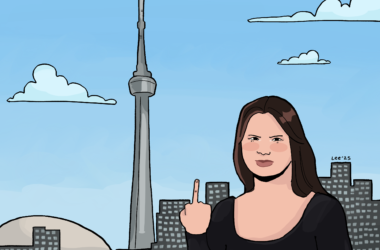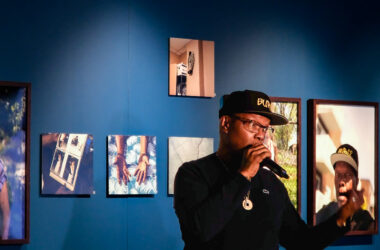Public art is a hot-button topic of discussion, be it in political debates or around the dining room table. While some denounce it as a frivolous waste of tax-payer dollars, others applaud the cultural, economic, and societal advantages of investing in public art: Its presence can accentuate a neighbourhood’s unique character, highlight important social issues, and render the fine arts more accessible.
Montreal is no stranger to these benefits as home to over 1,000 officially sanctioned public artworks. Public art even ornaments McGill’s downtown campus, where you can find eye-catching sculptures such as Jonathan Borofsky’s Human Structures (2010), which features three tiers of brightly-coloured figures outside of Burnside Hall, and Barbara Hepworth’s Square Forms and Circles (1963), a highly abstract, geometric structure located steps away from the Milton Gates.
Montreal is home to an impressive collection of public art, but the crème de la crème is undoubtedly its murals. These eye-catching artworks can be found across the island, and they range from small-scale murals to expansive portraits stretched across buildings. You would be hard-pressed to find a resident who hasn’t noticed the city’s abundance of colourful murals, which attract attention from Montrealers and tourists alike. A quick Google search reveals several tours of Montréal’s urban street art, guiding interested individuals on foot, or providing detailed lists of must-see murals for self-guided adventures.
For those who prefer creating to observing, Montreal is also home to MURAL Festival, a yearly public art show that turns Saint-Laurent Boulevard into an open-air museum. Local, national, and international artists are invited to use the street’s building sides as their canvasses, producing creative new works that the public can view for free, furthering the festival’s mission of democratizing art. Set to take place from June 8 to 18, this year’s MURAL Festival will welcome celebrated street artists like OSGEMEOS, a Brazilian artistic duo composed of twin brothers Gustavo and Otavio Pandolfo, and Projet TXYNA, a local mural and digital art collective made up of five creatives. The Projet TXYNA team will undertake the task of reinventing one of Montréal’s iconic murals, the “Graffiti Granny” which overlooks the intersection of Saint-Laurent and Avenue des Pins.
While MURAL Festival effectively drums up support and viewership of public art during its 11 days of festivities, groups like MU, a charitable organization for unique mural art rooted in Montreal’s history and culture, hope to foster an appreciation for public art all year long. Elizabeth-Ann Doyle, MU’s artistic director and co-founder, maintains that public art is essential to preserving Montreal’s identity as a cultural metropolis.
“Montreal is a creative city. We should, as Montrealers, feel that in everyday life,” Doyle said in an interview with The Tribune. “Public art is the best central access to free art.”
Inspiration for MU’s inception struck while Doyle was visiting Philadelphia alongside co-founder Emmanuelle Hébert for their work with Cirque du Soleil. Stirred by Philadelphia’s Mural Arts Program and the economic and social benefits it brought to the city, the pair vowed to establish a similar program back home. The result? MU, which has produced more than 300 murals since 2007 in an effort to help Montrealers get their daily dose of art.
The organization prioritizes artwork that pays tribute to the city’s creatives. Since 2010, MU has produced two to three murals per year that acknowledge Montreal’s trailblazing artists.
“We wanted to give a voice and honour artists as opposed to traditional public art, which [pays] tribute to military men or politicians,” Doyle said. “Quebec’s history is important. Recognition of its storytellers is important.”
MU’s “Montreal’s Great Artists” series has yielded some of the city’s most recognizable murals. These include 2017’s Tower of Songs by El Mac and Gene Pendon, a large-scale portrait on Crescent Street of acclaimed singer-songwriter and Westmount native Leonard Cohen, as well as Magnetic Art (2022) by Marc Séguin, a piece in the heart of Milton Parc dedicated to visual artist Jean-Paul Riopelle.
Another mural in the MU-produced series, Hommage À Alanis Obomsawin (2018) by artist Meky Ottawa, demonstrates how the medium can serve to highlight Indigenous artists and their cultures in a primarily settler-colonial setting. As a portrait of celebrated Abenaki Canadian-American filmmaker and activist Alanis Obomsawin, the mural paints the artist from the chest upwards, setting her against an azure sky dotted with constellations. The artwork is situated at the corner of Atwater and Lincoln in the Ville-Marie borough and serves as an important reminder of how Indigenous creators and their artistic contributions have shaped Canada’s artistic landscape.
In an email to the Tribune, Gloria Bell, an assistant professor of art history at McGill, emphasized the capacity of public art一especially murals一in highlighting Indigenous experiences and contributions.
“Public art such as murals are more accessible than finding artworks in traditional white cube galleries and museums,” Bell wrote. “The large scale of the work is powerful in its visibility and acknowledgement of Indigenous artists.”
In the case of Hommage, the mural pulls double-duty to further Indigenous representation: Not only does the artwork itself depict an Indigenous creative, but it also platforms Ottawa, an emerging, multi-disciplinary Atikamekw artist whose work incorporates traditional Indigenous techniques.
“[Obomsawin] seems to be crowned by traditional Abenaki floral motifs, a fitting crown for the queen of Indigenous media,” Bell wrote.
In addition to creating space for Indigenous artists and artworks, the murals of Montreal help spark important conversations about social issues. For instance, the mural Finding Home Again (William Daniel Buller, 2022), commissioned by Médecins Sans Frontières (MSF) in association with MU, explores the topic of forced migration. Depicting a woman carrying a sleeping child in her arms and a home strapped to her back, the mural stretches across the wall of a four-story apartment complex. Lines from the poem “immigrant” by Rupi Kaur complete the work, stretching across the bottom-right corner in both French and English:
“they have no idea what it’s like / to lose home at the risk of / never finding home again / to have your entire life / split between two lands and / become the bridge between two countries.”
The artwork is a stark and poignant reminder of the struggle of more than 100 million people worldwide who have been forced to uproot their lives to find refuge elsewhere. Located in the neighbourhood of Côte-des-Neiges (CDN), one of Canada’s most ethnically diverse communities, this mural reflects the forced displacement many of the neighbourhood’s residents have experienced.
“We feel that art is for everybody, and it should be grassrooted,” Doyle explained. “It talks to communities, so it has to talk about subjects that echo in those areas.”
The mural was unveiled on Oct. 24, 2022. Doyle emphasized the importance of its placement, which is situated prominently on the border of CDN and the Town of Mont-Royal. By displaying the mural in such a highly trafficked area, it serves as an organic catalyst for conversations about forced migrations for anyone who passes by.
Public art, and murals especially, plays a foundational role in sculpting Montreal as a cultural milieu. To Doyle, the question of whether public art is a luxury is a resounding no.
“Art is essential to life,” she said. “If [Montreal is] really a cultural city, that means not only having lots of programming. It goes beyond shows. It has to be lived by everybody, everywhere.”









